Download Pdf [4,89 MB] - MTU Aero Engines
Download Pdf [4,89 MB] - MTU Aero Engines
Download Pdf [4,89 MB] - MTU Aero Engines
Create successful ePaper yourself
Turn your PDF publications into a flip-book with our unique Google optimized e-Paper software.
Cover Story<br />
The beginnings<br />
Among them is Karlheinz Koch. The managing<br />
director of Turbo-Union, the consortium<br />
managing the Tornado’s RB199 engine, had<br />
long been working with <strong>MTU</strong> and, before<br />
that, served in the GAF as a pilot and wing<br />
commander. He remembers the early days:<br />
“In the late fifties, the decision to procure<br />
the U.S. Starfighter and its J79 engine set<br />
the stage for the extensive, close type of<br />
cooperation between the German engine<br />
industry, the GAF and the Bundeswehr<br />
Technical Center 61.” He goes on to add:<br />
“The General Electric engine was an inspired,<br />
robust design of extraordinary supersonic<br />
capabilities. In joint GAF-industry testing, it<br />
underwent various technical modifications to<br />
become the J79-J1K variant.” The next version,<br />
the J79-17A, then powered the F-4<br />
Phantom. Here, again, military-civil team-<br />
Military pilots called the Starfighter with its revolutionary J79 engine the ‘Porsche of the skies’.<br />
work accomplished the feat of doubling<br />
maintenance intervals through jointly<br />
achieved material optimizations and design<br />
improvements.<br />
The next aircraft to appear on the European<br />
scene was the Tornado, the first multinational<br />
multi-role combat aircraft. Its engine, the<br />
RB199, again was an international effort. The<br />
participating nations Germany, the U.K. and<br />
Italy bundled their activities under the roof of<br />
Turbo-Union. “Its Starfighter and F-4<br />
Phantom engine background predestined<br />
<strong>MTU</strong> for a major development role in the<br />
Tornado engine program,” remembers Karl-<br />
Josef Bader, who too had done a stint in the<br />
GAF. He supervises the RB199 program at<br />
<strong>MTU</strong> and knows the Tornado engine inside<br />
out. At the time of its entry into service in<br />
1984, Bader served as a maintenance officer<br />
with the GAF. “I was able to apply the lessons<br />
learned in those days and bring them to bear<br />
in the Eurofighter EJ200 logistic support<br />
effort.”<br />
For the GAF, the F-4 Phantom II became a workhorse that because of its robustness could be deployed in<br />
multiple roles.<br />
Cooperative model of engine<br />
maintenance<br />
The Eurofighter/Typhoon is the most advanced<br />
aircraft in its class. It’s a four-nation<br />
product, with Germany, the U.K., Italy and<br />
Spain jointly building aircraft and engine.<br />
Each partner contributes its most advanced<br />
technologies to the concerted effort. From<br />
the engine maintenance aspect, new trails<br />
are being blazed as well. In Germany, <strong>MTU</strong><br />
and the GAF have launched an industry-military<br />
cooperative model of engine maintenance,<br />
where the engines are still being<br />
maintained in a shared effort, but where that<br />
effort, formerly distributed, has now been<br />
co-located at a single site: <strong>MTU</strong>’s Munich<br />
facility. For three years already, GAF personnel<br />
and <strong>MTU</strong> staff have here been working<br />
shoulder to shoulder under the industrial<br />
leadership of <strong>MTU</strong>. The advantages are readily<br />
apparent: cost and time savings are<br />
achieved by pooling resources and reducing<br />
inventory capacities.<br />
The J79, too, now belongs to the family of engines<br />
maintained under the cooperative model. Its repair<br />
continues to be done in Munich.<br />
The EJ200 was the first engine to be maintained<br />
under the cooperative model.<br />
“The new concept is a win-win situation,”<br />
emphasizes Martin Majewski, head of <strong>MTU</strong><br />
customer support: “The GAF detaches maintenance<br />
mechanics to <strong>MTU</strong>, but also young<br />
officers with a graduate degree in engineering.<br />
They’re assigned to program control and<br />
product support. The military personnel<br />
work side by side with <strong>MTU</strong> staff on many<br />
complex tasks, such as spare parts management<br />
and requirements forecasting, or damage<br />
investigation and product tracking. They<br />
stimulate us in our work, communicating<br />
their experience and practical know-how. In<br />
return, they help the GAF maintain its engine<br />
know-how.”<br />
The cooperative model has been so successful<br />
that it is currently being expanded to<br />
include further engines. According to<br />
Weingartner, “we’ll also be repairing the<br />
RB199 (Tornado), the J79 (Phantom) and the<br />
RR250-C20 (PAH-1 helicopter)”. While the<br />
EJ200 and J79 will be repaired at <strong>MTU</strong>’s<br />
Munich facility, work on the other two<br />
The Tornado’s RB199 engine will now be repaired<br />
in <strong>MTU</strong>’s Erding branch facility.<br />
engines will occur at <strong>MTU</strong>’s Erding branch<br />
facility in future. “This type of cooperation<br />
benefits the armed forces economically,<br />
makes sure stringently needed military capabilities<br />
are preserved and helps secure the<br />
jobs of 60 civilian GAF employees,” appreciated<br />
Dr. Jörg Kaempf, the defense ministry’s<br />
director general of armaments, last November<br />
when the expanded maintenance model<br />
was inked. Ulrich Ostermair, cooperative<br />
model project manager at <strong>MTU</strong>, is emphatic<br />
that “the cooperative model marks the culmination<br />
of the partners’ trusting cooperative<br />
relationship”.<br />
The Tornado with its twin RB199 engines currently forms the backbone of the GAF fleet.<br />
Coming in from the cold<br />
When after the German unification the<br />
former German Democratic Republic’s<br />
(GDR) troops were integrated into the<br />
West-German military, the shifting<br />
wind blew a cold-war phantom into the<br />
GAF’s purview: the MiG-29, a Russian<br />
fighter bomber prodigy the West had<br />
so far known mostly from hearsay. The<br />
GDR’s most advanced combat aircraft<br />
easily matched the better fighters the<br />
West could field at the time. At the<br />
GAF, the MiG-29 became the shining<br />
star of its fighter arsenal.<br />
All MiG-29s were surrendered to the<br />
GAF at Preschen and until retired served<br />
in the “Steinhoff Fighter Wing 73” at<br />
Laage near Rostock. Pilots of Western<br />
air forces were hot to try the MiG to<br />
see how good it really was. Their consensus<br />
was that the spooky bird<br />
indeed had deadly talons, and with<br />
what they had seen they were glad<br />
they never had to seriously go head to<br />
head with it.<br />
The Russian fighter wasn’t retired until<br />
the Eurofighter was fielded, initially<br />
again at the Laage air base. 22 of the<br />
MiG-29s were leased under a Nato aid<br />
program to Poland, where they’re still<br />
flying today.<br />
For additional information, contact<br />
Odilo Mühling<br />
+49 <strong>89</strong> 14<strong>89</strong>-2698<br />
Further information is available on the<br />
Internet at: www.mtu.de/report<br />
6 REPORT REPORT 7


![Download Pdf [4,89 MB] - MTU Aero Engines](https://img.yumpu.com/5322947/4/500x640/download-pdf-489-mb-mtu-aero-engines.jpg)


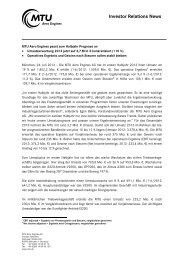
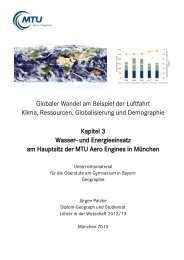
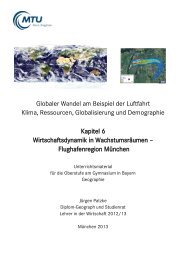
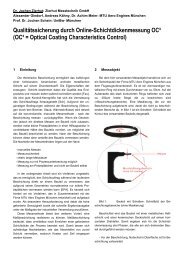
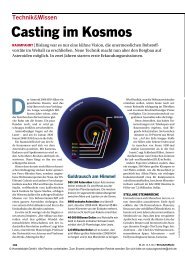

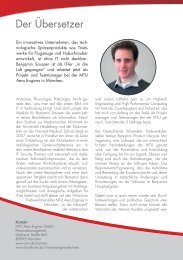
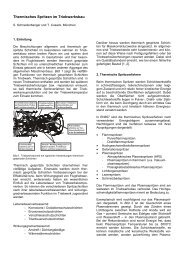
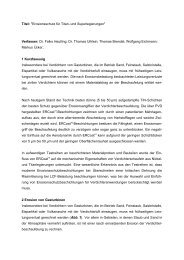


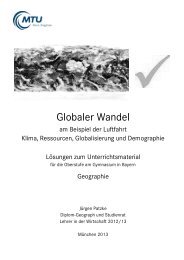
![Download PDF [5,37 MB] - MTU Aero Engines](https://img.yumpu.com/21945461/1/190x125/download-pdf-537-mb-mtu-aero-engines.jpg?quality=85)